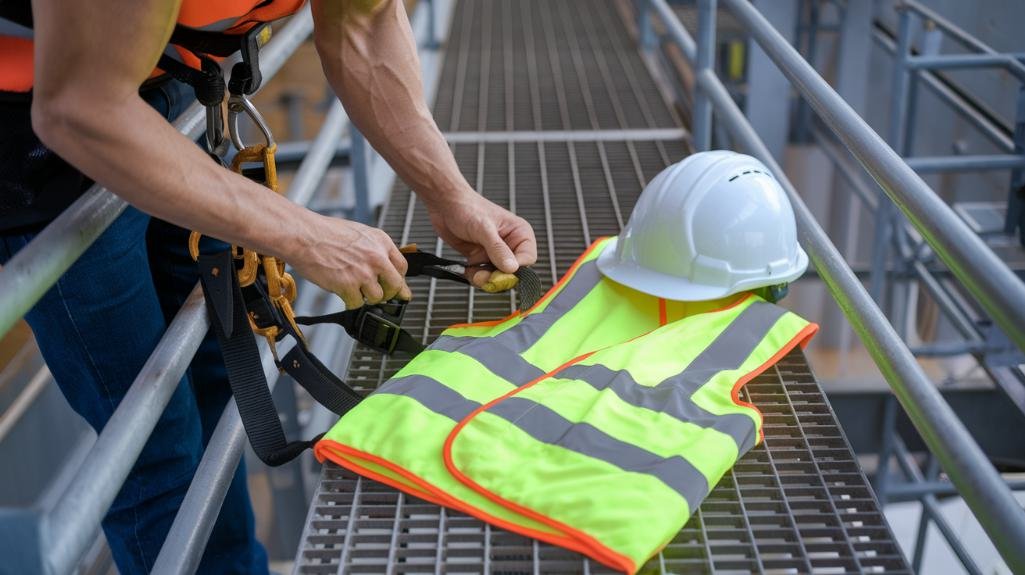You'll need to prioritize safety during employee onboarding because one-third of workplace injuries occur in an employee's first year. New hires face heightened risks due to limited experience and pressure to prove themselves, often overlooking essential safety protocols. By implementing thorough safety training early, you can reduce workplace injuries by up to 30% and cut operational costs by 20-25%. Understanding the core components of effective safety orientation will help protect your workforce and bottom line.
Key Takeaways
- One-third of workplace injuries occur during an employee's first year, making early safety training crucial for accident prevention.
- Effective safety onboarding reduces workers' compensation claims, saving an average of $42,000 per incident.
- New employees face increased risks due to limited experience and pressure to prove themselves in unfamiliar environments.
- Early safety training establishes proper habits, leading to 10% more effective work performance and 20-25% lower operational costs.
- Structured onboarding with safety protocols helps achieve 14% higher OSHA compliance rates and creates lasting safety-conscious behaviors.
The Critical First Year: Understanding New Hire Safety Risks

One in three workplace injuries involves employees in their first year on the job, making this initial period a vital focus for safety management.
Your new employees face heightened risks due to their limited experience with workplace hazards and industry-specific safety protocols. During the onboarding process, you'll need to address common challenges that increase injury rates among newcomers.
New hires often feel pressure to prove themselves, which can lead to unsafe practices and reduced safety awareness.
Without proper supervision and thorough safety orientations, they're more likely to overlook important injury reporting procedures and safety protocols.
You must recognize that many of your new employees may arrive with inadequate prior safety training, creating dangerous knowledge gaps that require immediate attention through structured workplace safety programs. Moreover, ensuring safety training documentation is part of the onboarding process establishes a foundation for ongoing safety compliance and employee awareness.
Building a Foundation: Core Components of Safety Orientation
To protect new employees from first-year injury risks, you'll need to implement an extensive safety orientation program built on proven fundamentals.
Begin with tailored safety training that addresses role-specific hazards and emergency procedures. Incorporate engaging presentation methods, combining hands-on demonstrations with visual aids to maximize comprehension and safety awareness.
- Establish clear accident reporting protocols and provide access to safety manuals for quick reference
- Customize training content based on job-specific hazards and workplace risks
- Conduct interactive demonstrations of safety equipment and emergency response procedures
- Implement follow-up assessments to verify understanding and identify knowledge gaps
Remember that effective safety orientations go beyond basic compliance – they create a foundation for long-term workplace safety culture and help prevent the high incidence of injuries among new employees. Additionally, integrating DEI training into your onboarding process can foster a more inclusive environment that enhances overall safety and employee engagement.
Measuring Success: Safety Training Assessment Methods

Effective assessment of safety training requires multiple evaluation methods to verify comprehension and practical application.
You'll need to implement post-training evaluations, including quizzes and hands-on tests, to identify knowledge gaps in your employee onboarding process.
Monitor real-world applications through direct observation to guarantee employees are correctly implementing safety protocols.
Gather continuous feedback from your team about training effectiveness, which will help you refine and improve your safety programs.
By combining different assessment methods, such as simulations and practical demonstrations, you'll strengthen employees' ability to apply safety measures confidently.
This thorough approach to measuring training success contributes to a robust safety culture and improved compliance.
Regular assessments help you track progress, address concerns promptly, and maintain high safety standards throughout your organization.
Beyond Day One: Creating Lasting Safety Habits
While initial safety training provides a foundation, developing lasting safety habits requires a sustained commitment to continuous learning and practice.
You'll need to foster a workplace culture where safety remains a top priority through regular refresher courses and hands-on training. By incorporating real-world scenarios and employee feedback, you'll strengthen your team's ability to proactively identify and address potential hazards.
- Schedule periodic safety training sessions that include practical demonstrations and role-playing exercises
- Implement a feedback system to gather insights on training effectiveness and areas needing improvement
- Document and analyze workplace incidents to refine safety protocols and training materials
- Create accountability measures to guarantee employees are consistently adhering to safety protocols and actively participating in continuous learning initiatives
These steps will help minimize workplace injuries and cultivate lasting safety habits throughout your organization. Additionally, utilizing data-driven insights from onboarding strategies can enhance the effectiveness of your safety training programs.
The Business Case: Safety Training's Return on Investment

A compelling financial argument exists for prioritizing safety training during employee onboarding.
You'll reduce workplace injuries by up to 30%, saving an average of $42,000 per workers' compensation claim while cutting operational costs by 20-25%. Your investment in thorough safety training directly impacts employee retention, producing a 21% boost in loyalty and significant savings on turnover expenses.
Safety training cuts injuries by 30% and saves $42,000 per claim, while boosting employee loyalty and reducing turnover costs.
You'll also strengthen your compliance position, achieving a 14% higher compliance rate with OSHA regulations. This improvement helps you avoid substantial fines ranging from $13,653 to $136,532 per violation.
Beyond regulatory benefits, you'll see a measurable return on investment through enhanced workforce productivity, with trained employees performing at least 10% more effectively in their secure work environment.
These numbers demonstrate that safety training isn't just a mandatory requirement—it's a strategic business investment.
Frequently Asked Questions
Why Is It Important to Prioritize Safety in the Workplace?
Would you risk your team's well-being? You must address workplace hazards through employee training, risk assessment, and strong safety culture. Proper incident reporting and compliance standards protect both lives and your company's bottom line.
Why Should We Put Priority to Safety?
You'll protect lives and assets by fostering safety culture, ensuring compliance training, and promoting risk awareness. It is crucial to maintain mental wellbeing while following emergency procedures and incident reporting protocols.
What Are the 4 C's of Employee Onboarding?
Your onboarding process includes four essential C's: Compliance (regulatory requirements), Clarification (job expectations), Culture (team dynamics), and Connection (mentorship opportunities) – all crucial for new hires' successful integration and engagement.
Why Is Workplace Safety Important and What Does It Mean by Safety First?
Like a shield against danger, workplace safety protects you through safety protocols, risk assessment, and emergency procedures. You'll maintain compliance standards while following preventive measures to avoid hazards and report incidents.


